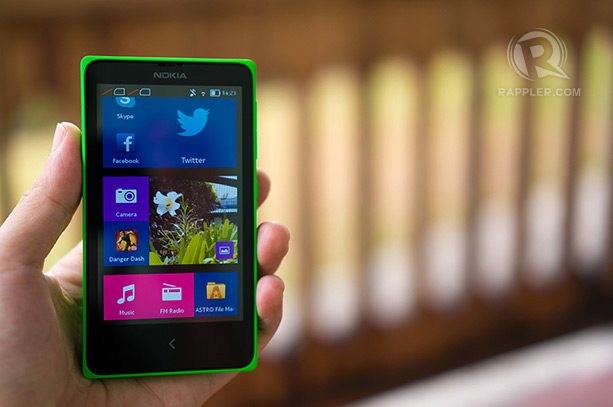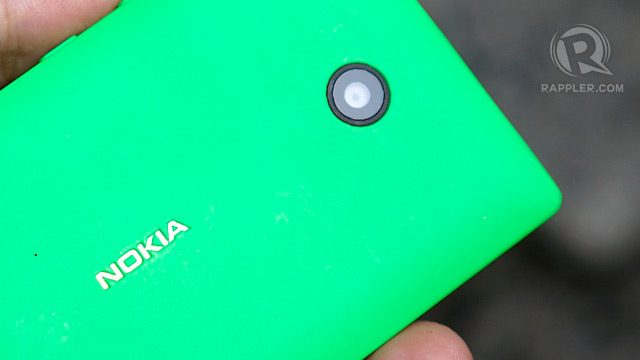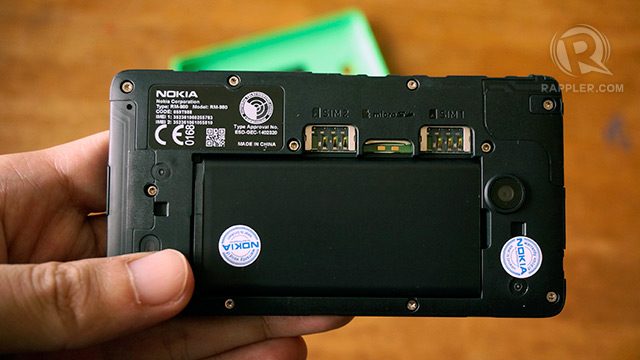SUMMARY
This is AI generated summarization, which may have errors. For context, always refer to the full article.
MANILA, Philippines — Once a dominant force in the world of mobile phones, Finnish cellphone manufacturer Nokia stands in the shadow of its former glory because of decisions made in the past.
The landscape would have been different had Nokia adopted Android as its smartphone operating system (OS). Instead, it cast its bets on Windows Phone, a smartphone OS beleaguered by a growth-stunted app ecosystem.
With Lumia, Nokia continues a time-honored tradition of excellence in design dating back to the candy bar 5110 of the late nineties – even the fashion-savvy, problem solving gladiator Olivia Pope picks the Lumia as her phone of choice. But one can’t sell smartphones on design alone, and with Windows Phone at its core, Nokia isn’t the powerhouse that it used to be.
That’s why when rumors swirled of an Android-powered Nokia phone in the works, we had high hopes and great expectations.
Perhaps we expected too much – when the Nokia X arrived last March it was a big let down. Not even impeccable design and trademark sturdiness could overshadow the fact that the device was merely a rehash of existing devices without the essence of the Android.
Middle child
To appreciate the Nokia X is to understand where it fits inside Nokia’s product lineup and who it is intended for. The phone is designed for emerging markets like Southeast Asia, India, and parts of Africa – blue ocean for manufacturers looking to expand market reach.
 According to Nokia, the X belongs in the middle of its feature phone Asha line and its Windows Phone-powered Lumia line. In the Philippines, the most expensive Asha 503 is priced at P5,200 ($117.40), the Nokia X at P5,990 ($135.25) and the entry-level Lumia 520 at P7,990 ($180.40).
According to Nokia, the X belongs in the middle of its feature phone Asha line and its Windows Phone-powered Lumia line. In the Philippines, the most expensive Asha 503 is priced at P5,200 ($117.40), the Nokia X at P5,990 ($135.25) and the entry-level Lumia 520 at P7,990 ($180.40).
But with barely a noticeable price margin between the Asha and the Nokia X and striking similarities between their designs, one can’t help but look for differentiators to justify their co-existence, a value-added to warrant the creation of a separate product class.
One could argue that the Asha is a feature phone and the Nokia X a smartphone.
Feature phones are typically closed systems that do not not allow third-party app development. But the Asha isn’t your typical feature phone with apps and OS updates that make it feel closer to a smartphone, close being the operative word.
Despite its strengths, Asha is not quite the vibrant, open and rich experience of Android. This is where the Nokia X was supposed to have made a difference but it is also where it fell short.
Nokia’s Android
Any smartphone manufacturer worth its salt has taken Android and given it its own spin, most notable are Samsung’s TouchWiz and HTC’s Sense. Nokia’s take on Android 4.1.2 Jellybean (three updates older than the current iteration of Android) is inspired by its other phone offerings.

From Asha the Nokia X gets Fastlane a notification drawer that also displays frequently used apps. It also shares the same back button, where the home button is found on most smartphones. From Windows Phone it borrows the tile interface although these ones aren’t dynamically populated with content. There’s at least one more gem also worth mentioning, notifications on the Lock Screen something that stock Android has so far been unable to manage.
Overall though, Nokia’s Android doesn’t feel like Android at all, there’s no app drawer or customizable home screen – most glaring is the absence of Google. It sounds almost sacrilegious, Android is after all Google’s smartphone OS with Google services weaved into the experience. You log into your Google account when you set up your phone, use your Gmail account to sync phone contacts and speak “Okay Google” to your virtual assistant. At the core of the Android experience is Google Play Store – a repository of more than a million apps plus music and books.
There’s no Google Play on the Nokia X leaving users with Nokia’s curated Android Store as the main source for apps. Like on Windows Phone the app selection on Nokia’s Android Store is paltry, and searches for commonly used apps like Chrome, Instagram and WhatsApp lead to a dead end. Other Google apps like Maps, Gmail and YouTube are unavailable also.
Nokia said most Android apps will work on the Nokia X and tech savvy users can side load apps onto the device – a not so difficult but potentially risky process that entails downloading an app installer onto the device itself. Users can also get apps via third-party stores like 1Mobile Market or APTOiDE. Why it wouldn’t just make it easier for consumers conflicts me, then again it wouldn’t be fair either for the budget phone to have a bigger app library than its premium older brother would it?
For Nokia it makes business sense. The displacement of Google was done with future owner Microsoft’s interest at heart – Microsoft services like Skype, OneDrive and Outlook are closely integrated into the Nokia X. Nokia CEO Stephen Elop said the shift to take people to Microsoft’s cloud instead of Google’s was intentional, “We are deliberately using Android, but substituting Nokia services. We have Android app compatibility while introducing the next billion people to Microsoft. This is a gateway to Microsoft.”
And so the Nokia X is an Android smartphone stripped of its Google roots, merely a bridge device that aims to give feature phone users a taste of Windows Phone.
Managed Expectations
It would be unfair to compare the Nokia X with the current crop of flagship smartphones, for a flagship phone the Nokia X is not. In fact this budget phone operates on the most basic of specs – a 1 GHz dual-core processor, 512MB of RAM, 4GB of storage and a 4-inch 800×480 IPS display.
Benchmarking test Antutu scores the phone at 7572 slower than Samsung’s similarly priced dual-sim phone the Galaxy S Duos 2 which scores an even 12000. Everything from sending a text message, launching the camera, or scrolling down a webpage is a tad bit sluggish.

The Nokia X’s camera is also a downer – a 3 megapixel fixed focus shooter with no autofocus. No autofocus means you’re stuck with what’s within focus distance of your lens, so close pictures may be blurry and there’s no way to isolate your subject from the background. If you’re looking to take selfies then look elsewhere, the Nokia X has no front facing camera (the $150 Nokia XL coming in Q2 2014 will have a front facing camera).

One redeeming factor is the device’s battery life. While equipped with only a 1500 mAh battery, the Nokia X lasted a full day and then some even with both SIM cards active and 3G and WiFi turned on. Its display also deserves mad props, in true Nokia fashion the screen on the X has deep blacks with vibrant colors and great contrast.
That being said, even with lowered expectations it’s still hard not to expect more from the Nokia X. For $40 dollars more you can get the Moto G with a faster quad-core processor, double the memory and storage, and a better camera.
Then there are the made-in-China smartphones slapped with local branding and sold across Southeast Asia. In the Philippines the 5-inch, HD, quad-core MyPhone Rio with an 8MP camera retails for an impressive P4995 ($112) price tag – P995 ($22.50) cheaper than the Nokia X but with specs that are at least 4 times better and with a true Android experience.
Confusion and challenge

Would I recommend the Nokia X? If you’re keen on a Nokia phone, sure why not. I’ve dropped enough Nokia phones to trust that Nokia X will be as solid and rugged as every other Nokia sold today, the range of colors options are great and the rubberized matte finish reminds me of my trusty Nexus 5. But the first thing I’d do is root the device, install Google Launcher and bring back Google Play. In the process I’d void my warranty, a small price to pay for legitimate Android phone.
Nokia’s strategy is clear. Capture the “fastest-growing segment of the smart phone market” and bring them over to Windows. But why not then just offer then a cheaper Lumia? The underlying issue here is one of economics. The Nokia X is built on a platform called the Android Open Source Project (AOSP) which requires less expensive hardware, Windows Phone on the other hand has more expensive tastes.
That might just change soon, last April 15 Microsoft opened up its OEM portal for Windows Phone giving anyone who wants to create a Windows Phone the information to do just that. Microsoft has also loosened hardware requirements and no longer requires a dedicated camera button and physical buttons.
A little too late perhaps for Nokia. You’d think that with the impending acquisition of Nokia’s phone business by Microsoft they could have worked this out sooner. But despite Nokia’s insistence perhaps Microsoft was never fully on board.
At the 2014 Mobile World Congress in Barcelona, a day before the launch of the Nokia X, Windows Phone Chief Joe Belfiore had this to say about the idea of Nokia flirting with Android, “some things we’re excited about, some things we’re less excited about.”
I don’t blame him. I’ve always wanted an Android phone in a Lumia body, but neither here nor there, the Nokia X is not the phone it had the potential to be and I think its best we leave it at that. – Rappler.com
Add a comment
How does this make you feel?
There are no comments yet. Add your comment to start the conversation.